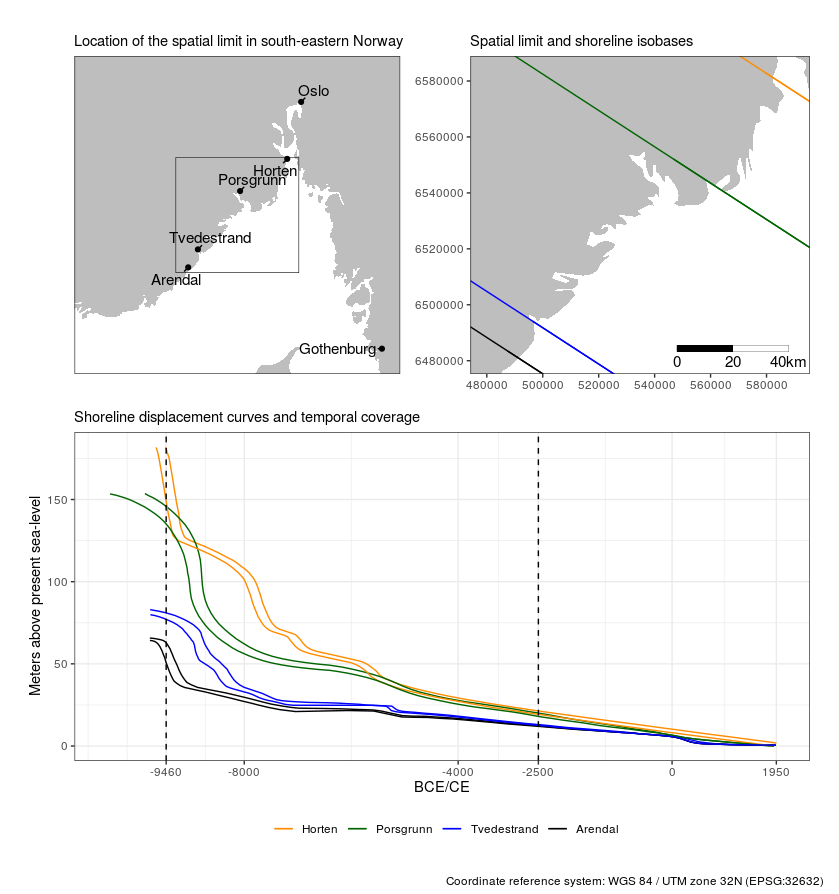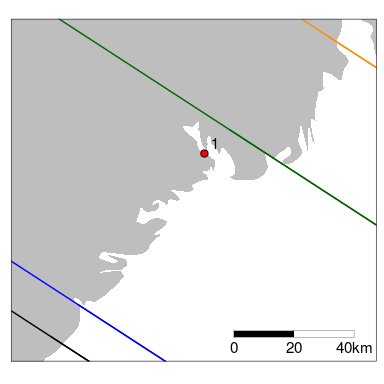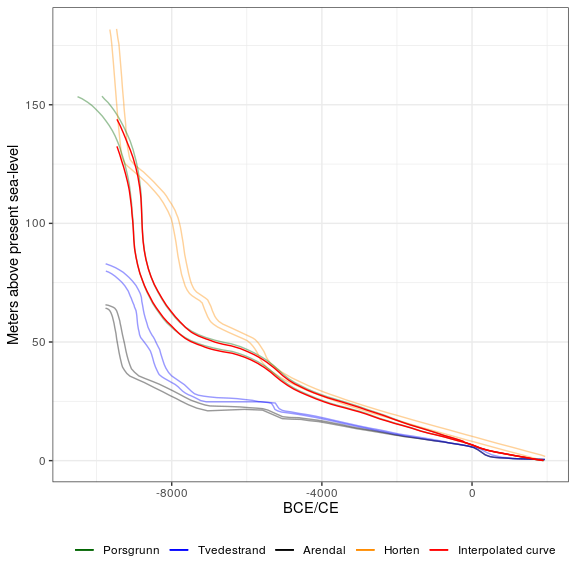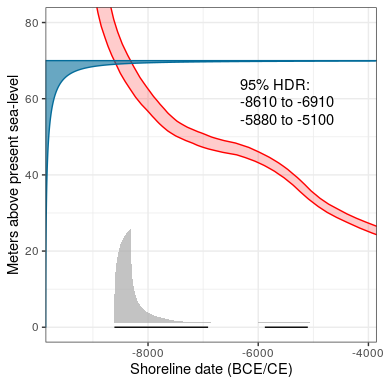
The package shoredate offers methods to shoreline date Stone Age sites located along the Norwegian Skagerrak coast based on their present-day elevation and the trajectory of past relative sea-level change. Shoreline dating is based on the premise that coastal Stone Age sites in the region were located on or close to the shoreline when they were in use, and is implemented here based on an empirically derived estimate of the likely elevation of the sites above sea-level when they were occupied (Roalkvam 2023). However, do note that as the Roalkvam (2023) study provides a first formalisation of the method, it is hefted with unexplored uncertainties, and as the method is dependent on regularities in human behaviour, the dates achieved with the package should be treated with care.
You can install the development version of shoredate from GitHub with:
# install.packages("devtools")
devtools::install_github("isakro/shoredate")The package can then be loaded:
library(shoredate)As the method of shoreline dating is determined by relative sea-level change, it is dependent on reliable geological reconstructions of this development. At present, the method as outlined here is therefore limited to being applicable in the region of south-eastern Norway between Horten in the north east to Arendal in the south west. This region has newly compiled shoreline displacement curves for Horten (Romundset 2021), Porsgrunn (Sørensen et al. 2014; Sørensen et al. 2023), Tvedestrand (Romundset 2018; Romundset et al. 2018) and Arendal (Romundset 2018). The region also formed the study area for Roalkvam (2023), in which the method and its parameters were derived. The spatial coverage is indicated in the maps below. The shoreline isobases in the second figure represent contours along which the shoreline displacement has followed the same trajectory. These correspond to the displacement curves and place names in the third figure, which also indicates the temporal coverage of the package.
Note that spatial data used with the package should be set to WGS 84 / UTM zone 32N (EPSG:32632).

As human occupation in the region only occurred some time after the retreat of the Fennoscandian Ice Sheet, the currently oldest known sites in Norway are from around 9300 BCE (e.g. Glørstad 2016). The oldest possible age to achieve with shoredate is 9460 BCE, although no sites are yet known to be that old. A warning is given if a site location is outside the spatial extent outlined above, as this involves a more uncertain extrapolation of the development of shoreline displacement. However, the dating procedure is still performed. Conversely, if a site has an elevation that implies a date older than 9460 BCE the date is returned as NA and a warning is given.
In Roalkvam (2023) it was found that sites tend to be located on or close to the shoreline up until around the transition to the Late Neolithic, c. 2500 BCE, which thus marks the upper limit for the applicability of the method. A date that has a later start date than this is therefore returned as NA with a warning. The temporal range is indicated by the dashed lines in the plot above that displays the shoreline displacement curves. Additionally, if the probability of a date extends beyond 1950 CE (0 cal BP), thus indicating a site location below the present-day sea-level, this overshooting probability is cut off and the date is normalised to sum to unity.
To shoreline date a site, a reconstruction of local shoreline displacement is necessary. There are currently four reliable geological displacement curves available from within the study area. Each of these is associated with a shoreline isobase, along which the trajectory of relative sea-level change has been the same. To find the local displacement curve, the curves are interpolated to a site location using inverse distance weighting, where the default is to weight the interpolation by the square of the inverse distance between site and isobases.
# Create example point using the required coordinate system WGS84 / UTM zone 32N (EPSG: 32632)
target_point <- sf::st_sfc(sf::st_point(c(538310, 6544255)), crs = 32632)
# Simple map showing the target location relative to the isobases of the displacement curves
target_plot(target_point)
# Interpolate shoreline displacement curve for the target location
target_curve <- interpolate_curve(target_point)
# Plot displaying the interpolated curve
displacement_plot(target_curve)
This interpolation is performed under the hood for each site when
calling shoreline_date(), which performs the shoreline
dating procedure.
Below is a basic example outlining how to date a single site by manually specifying the site elevation. The default settings are used for the dating procedure and for plotting the resulting shoreline date.
# Using the example point from above and specifying it's elevation
target_date <- shoreline_date(site = target_point, elevation = 70)
# Call to plot
shoredate_plot(target_date)
The blue gamma distribution on the y-axis represents the likely elevation of the site above sea-level when it was in use, which is described by an empirically derived gamma distribution with the parameters \(\alpha\) (shape) = 0.286 and \(\sigma\) (scale) = 0.048 (see Roalkvam 2023 for more details). This starts from the elevation of the site. The red envelope is the shoreline displacement curve as interpolated to the site location. The probability from the gamma distribution is transferred to the calendar scale using the displacement curve. This gives the resulting shoreline date in grey, which is underlined by the 95% highest density region (HDR) in black. By default, the shoreline date is normalised to sum to unity. The default resolution on the calendar scale is 10 years.
Calling the date object, which has the custom class
shoreline_date, prints the name of the site, its elevation
and the HDR:
target_date
#> ===============
#> Site: 1
#> Elevation: 70
#>
#> 95% HDR:
#> 8610 BCE-6910 BCE
#> 5880 BCE-5100 BCEThe first column of a data frame beyond the geometry of the spatial
objects will be taken to represent site names. If no such column exist,
the sites are simply numbered as they are passed to
shoreline_date().
It is also possible to date multiple sites at once.
# Creating multiple points to be dated
target_points <- sf::st_sfc(sf::st_point(c(538310, 6544255)),
sf::st_point(c(538300, 6544250)),
sf::st_point(c(517491, 6511426)),
sf::st_point(c(502059, 6495402)))
# Specifying the correct CRS and making the points a sf data frame
target_points <- sf::st_as_sf(target_points, crs = 32632)
# Adding example names
target_points$name <- c("Example 1", "Example 2", "Example 3", "Example 4")
# Adding fictitious site elevations
target_points$elevation <- c(70, 46, 62, 30)
# Perform shoreline dating
target_dates <- shoreline_date(sites = target_points,
elevation = target_points$elevation)
# Print to console
target_dates
#> ===============
#> Site: Example 1
#> Elevation: 70
#>
#> 95% HDR:
#> 8610 BCE-6910 BCE
#> 5880 BCE-5100 BCE
#> ===============
#> Site: Example 2
#> Elevation: 46
#>
#> 95% HDR:
#> 6660 BCE-3180 BCE
#> ===============
#> Site: Example 3
#> Elevation: 62
#>
#> 95% HDR:
#> 8940 BCE-7720 BCE
#> ===============
#> Site: Example 4
#> Elevation: 30
#>
#> 95% HDR:
#> 7760 BCE-6020 BCE
#> 5610 BCE-2400 BCE
#> 2320 BCE-2140 BCE
#> 110 CE-430 CEThe default behaviour when providing multiple shoreline dates to
shoredate_plot() is to plot a series of individual plots.
However, setting multiplot = TRUE collapses the dates on a
single plot that is more sparse, ordering the sites from earliest to
latest possible start date for the occupation of the sites.
shoredate_plot(target_dates, multiplot = TRUE)
The procedures outlined above have focused on the basic functions and
default behaviours of the package. For further usage and a more detailed
walk through, see the vignette by calling
vignette("shoredate").
Glørstad, H. 2016 Deglaciation, sea-level change and the Holocene colonization of Norway. Geological Society, London, Special Publications 411(1):9–25. DOI: 10.1144/SP411.7
Romundset, A. 2018. Postglacial shoreline displacement in the Tvedestrand–Arendal area. In The Stone Age Coastal Settlement in Aust-Agder, Southeast Norway, edited by Gaute Reitan and Lars Sundström. Cappelen Damm Akademisk, Oslo, pp. 463–478. DOI: 10.23865/noasp.50
Romundset, A. 2021 Resultater fra NGUs undersøkelse av etteristidas strandforskyvning nord i Vestfold. Geological Survey of Norway, Trondheim.
Romundset, A., Lakeman, T.R. and Høgaas, F. 2018. Quantifying variable rates of postglacial relative sea level fall from a cluster of 24 isolation basins in southern Norway. Quaternary Science Reviews 197:175e192. DOI: 10.1016/ j.quascirev.2018.07.041
Roalkvam, I. 2023 A simulation-based assessment of the relation between Stone Age sites and relative sea-level change along the Norwegian Skagerrak coast. Quaternary Science Reviews 299:107880. DOI: 10.1016/j.quascirev.2022.107880
Sørensen, R, Henningsmoen, K.E. Høeg, H.I. and Gälman V. 2023. Holocen vegetasjonshistorie og landhevning i søndre Vestfold og sørøstre Telemark. In The Stone Age in Telemark. Archaeological Results and Scientific Analysis from Vestfoldbaneprosjektet and E18 Rugtvedt–Dørdal, edited by Per Persson and Steinar Solheim, in press.
Sørensen, R, Henningsmoen, K.E. Høeg, H.I. and Gälman V. 2014 Holocene landhevningsstudier i søndre Vestfold og sørøstre Telemark – Revidert kurve. In Vestfoldbaneprosjektet. Arkeologiske undersøkelser i forbindelse med ny jernbane mellom Larvik og Porsgrunn. Bind 1, edited by Stine Melvold and Per Persson. Portal forlag, Kristiansand, pp. 36–47. DOI: 10.23865/noasp.61
Contributions and suggestions for improvement are all very welcome. Instructions for contributing can be found in the Guide to Contributing. Please note that this project is released with a Contributor Code of Conduct. By participating in this project you agree to abide by its terms.